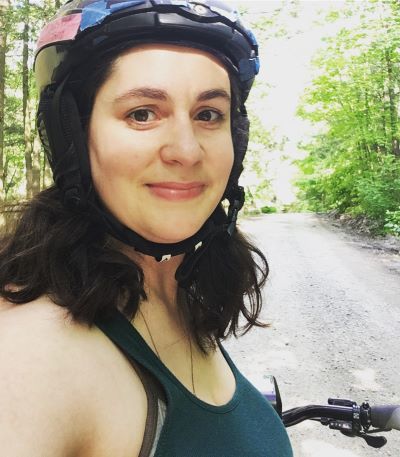Make your commute a conversation piece
ICF team members enjoy hobbies—and reduce their daily stress levels and carbon footprints—on their way to work.

- In the warmer months, it takes survey researcher Debbie Krug about an hour to bike from her rural Vermont home to ICF’s Burlington office. But the views are worth it. “I can see both Vermont’s Green Mountains and New York’s Adirondack Park. There’s nothing like it.” (During the winter, Debbie carpools or takes the bus.)
- Tyler Laberge, an energy analyst for ICF, also has a combination-commute, typically using public transit and bike to get to her St. Louis office. (“I carpool when I can’t bike,” she says. “Especially during the winter months.”) Not only does she get to enjoy views of the Arch each day, twice a day, but “I discovered free outdoor early morning yoga right by our office!”
- Human Resources’ Alex Stelmaszuk, who works at ICF’s London location, is an ardent Tube user. His advice: Make sure nothing gets caught in the doors before they close. “I watched a woman’s hair flapping in the tunnel one morning. When we got to the next station, her blonde ponytail had turned black!”
- Lindsey Antonie, part of our Europe & Asia marketing team, prefers to bike to work, primarily using the Tube only during the winter months. “On a ‘bad traffic light day’—I pass 28 lights!—it takes about 40 minutes to get to work. On a good day, it takes 25.” Her daily ride takes her away from most of London’s most famous landmarks. “But I get a nice view at some point of the city centre, where I can see the Gherkin.”
- Cara Politi, an ICF Next associate, takes the train to Grand Central Station then walks to our Midtown office in New York City. “It’s a really lovely commute,” she says. She also uses transit to visit clients—and interview offsite applicants. “I documented my trip for our 511NY Rideshare Instagram project.”
No matter the season, Debbie Krug enjoys her commute. “The scenery is so peaceful—it’s an automatic stress reducer.”
An easy commute makes the act of going to work as rewarding as doing the work. Not to mention that, many employers, including ICF, offer commuter benefits to offset parking fees or transit passes.
Of course, not everyone can use mass transit—or bike to work.
- It takes ICF recruiter Alka Saxena about 40 minutes to drive to ICF’s office in Delhi. “Our office is near the airport, so it’s fun to watch planes take off and land while commuting.”
1. Plan around traffic. If possible, start and end your days at off-hours. Leaving a few minutes before (or after) rush hour cuts a lot of time and hassle.
2. Set your playlist. Catch up on podcasts or listen to your favorite driving tunes while you transport yourself from Point A to Point B.
3. Breathe. When traffic gets tight—or public transit comes to an extended stop—keep your breath steady and calm. It will reduce your own tension and make a bad situation more bearable.
4. Share the road. Drivers: make room for cyclists, watch for motorcycles, and zipper merge when lanes end.
Senior communications manager Kate Brangaccio supports, among other ICF clients, the U.S. Department of Transportation, the Federal Highway Administration, and the National Highway Traffic Safety Administration. Her advice for a first-time transit user: “Take advantage of technology where you can.”
- Use the mobile ticket app to save time on buying passes.
- Follow your local transit agency on social media for alerts and notifications.
- Use your commute time for yourself—read, think, learn, or rest.
Eva Hsu agrees—and not just because she’s a transportation and smart mobility manager. When traveling (and sometimes at home, in New York City) she relies on apps like Google Maps to find the closest public transit stop or walking directions—and how long it will take to arrive at your destination.
Program planner Pearl Kaplan suggests easing into the transition. She avoids commuting in a single-occupancy vehicle to her Atlanta-based client site. “First, identify what options make the most sense for you. And know that it’s okay to use using multiple options,” she suggests. Like taking a carpool to mass transit. Second, set a clear goal. (“Tuesday will now be ‘Transit Tuesday.’”) It only takes a few weeks for the habit to form.